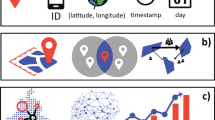
Overview
- Discusses the role of mobile network data in urban informatics, particularly how it is utilized in the mobility context
- Assesses the extent to which mobile network data reflects travel behavior and provides guidelines on how to best use it
- Provides a comprehensive introduction to mobile network data-based urban informatics in travel behavior research
Access this book
Tax calculation will be finalised at checkout
Other ways to access
About this book
Traditionally, survey-based information is used as an input for travel demand models that predict future travel behavior and transportation needs. A survey-based approach is however costly and time-consuming, and hence its information can be dated and limited to aparticular region. Mobile network data thus emerges as a promising alternative data source that is massive in both cross-sectional and longitudinal perspectives, and one that provides both broader geographic coverage of travelers and longer-term travel behavior observation. The two most common types of travel demand model that have played an essential role in managing and planning for transportation systems are four-step models and activity-based models. The book’s chapters are structured on the basis of these travel demand models in order to provide researchers and practitioners with an understanding of urban informatics and the important role that mobile network data plays in advancing the state of the art from the perspectives of travel behavior research.
Similar content being viewed by others
Keywords
Table of contents (9 chapters)
-
Front Matter
Authors and Affiliations
About the author
Santi Phithakkitnukoon is originally from Chiang Mai, Thailand. Santi is currently an Associate Professor with the Department of Computer Engineering, Faculty of Engineering, Chiang Mai University. He received B.S. and M.S. degrees in electrical engineering from the Southern Methodist University, USA, in 2003 and 2005, respectively, and a Ph.D. in computer science and engineering from the University of North Texas, USA. Before joining Chiang Mai University, he was a Lecturer in Computing with The Open University, U.K., a Research Associate with the Culture Lab (now known as Open Lab), Newcastle University, U.K., and a Postdoctoral Fellow with the SENSEable City Lab, Massachusetts Institute of Technology, USA. His research interest is in urban informatics, particularly in analyzing large-scale digital footprints such as mobile phone CDRs, GPS traces, social media data, and opportunistic sensing data sources to better understand human behavior and urban dynamics.
Bibliographic Information
Book Title: Urban Informatics Using Mobile Network Data
Book Subtitle: Travel Behavior Research Perspectives
Authors: Santi Phithakkitnukoon
DOI: https://doi.org/10.1007/978-981-19-6714-6
Publisher: Springer Singapore
eBook Packages: Computer Science, Computer Science (R0)
Copyright Information: The Editor(s) (if applicable) and The Author(s), under exclusive license to Springer Nature Singapore Pte Ltd. 2023
Hardcover ISBN: 978-981-19-6713-9Published: 30 November 2022
Softcover ISBN: 978-981-19-6716-0Published: 01 December 2023
eBook ISBN: 978-981-19-6714-6Published: 29 November 2022
Edition Number: 1
Number of Pages: XIII, 241
Number of Illustrations: 1 b/w illustrations
Topics: Data Structures and Information Theory, Artificial Intelligence, Data Mining and Knowledge Discovery, Statistics, general, Transportation Technology and Traffic Engineering, Computer Applications



